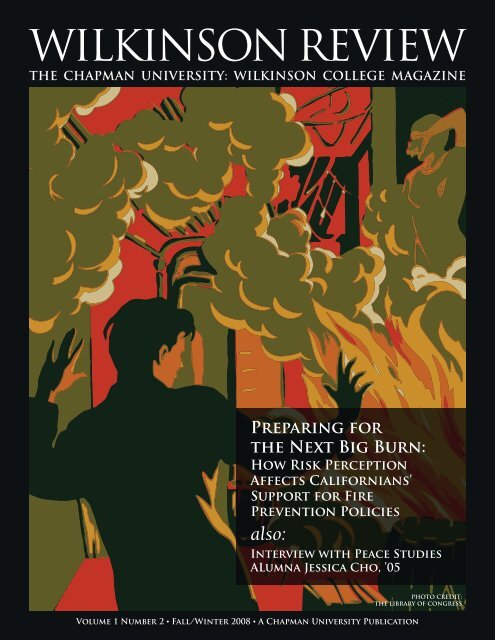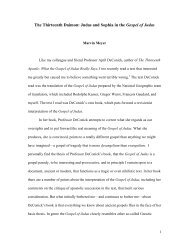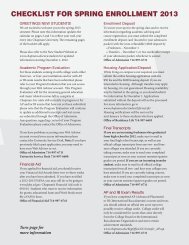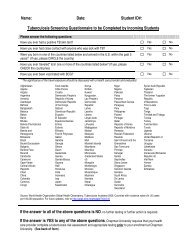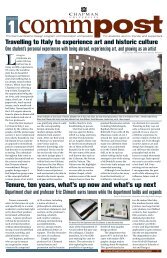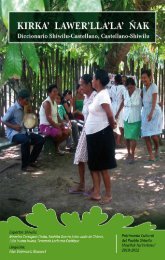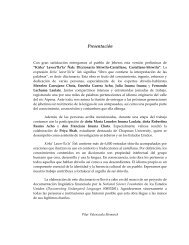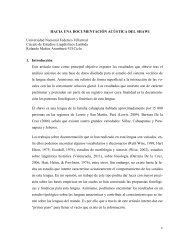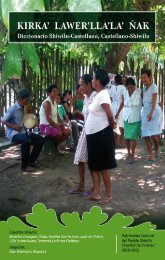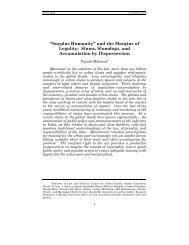WILKINSON COLLEGE MAGAZINE also - Chapman University
WILKINSON COLLEGE MAGAZINE also - Chapman University
WILKINSON COLLEGE MAGAZINE also - Chapman University
Create successful ePaper yourself
Turn your PDF publications into a flip-book with our unique Google optimized e-Paper software.
<strong>WILKINSON</strong> REVIEW<br />
THE CHAPMAN UNIVERSITY: <strong>WILKINSON</strong> <strong>COLLEGE</strong> <strong>MAGAZINE</strong><br />
<strong>also</strong>:<br />
Behind the Name …<br />
Roosevelt Hall<br />
Preparing for<br />
the Next Big Burn:<br />
How Risk Perception<br />
Affects Californians’<br />
Support for Fire<br />
Prevention Policies<br />
<strong>also</strong>:<br />
Interview with Peace Studies<br />
ALumna Jessica Cho, ’05<br />
Photo Credit:<br />
The Library of Congress<br />
Volume 1 Number 2 • Fall/Winter 2008 • A <strong>Chapman</strong> <strong>University</strong> Publication
<strong>WILKINSON</strong> REVIEW<br />
Message from the dean<br />
This issue of our Wilkinson Review is the first we are publishing under the<br />
banner of our newly named and reorganized college: Wilkinson College of<br />
Humanities and Social Sciences. Composed of the departments of Political<br />
Science, Sociology, History, Communication Studies, English, Religious Studies,<br />
Philosophy and Languages, we <strong>also</strong> proudly include the Rodgers Center for<br />
Holocaust Education, the Peace Studies Program, the Ludie and David C.<br />
Henley Social Science Research Laboratory and the Albert Schweitzer Institute.<br />
The award-winning student newspaper, the <strong>Chapman</strong> Panther, is a product of<br />
our journalism program, and Radio <strong>Chapman</strong> is broadcast through our<br />
department of Communication Studies. Students work with our distinguished<br />
faculty in these programs and in a variety of individualized scholarly projects<br />
and research efforts.<br />
I am proud to present this issue exemplifying Wilkinson faculty scholarship in<br />
both the humanities and the social sciences. The essays provide a look at faculty research and <strong>also</strong> reveal the way<br />
in which our faculty members, who pride themselves on being “Teacher Scholars,” inform their teaching through<br />
their ongoing thoughtful and critical scholarship. English Professor Richard Ruppel describes the way in which<br />
his piercing examination of the works of author Joseph Conrad engages his students in exploring the historical and<br />
contemporary world through the lens of literature. Through studying Conrad, Professor Ruppel guides his students<br />
to join him in considering war and peace, the rise and fall of colonial régimes and the interplay of human behavioral<br />
and moral actions on such a world stage. Dr. David Shafie, an assistant professor in the Department of Political<br />
Science who specializes in environmental policy, writes about the research that he and his colleagues have conducted<br />
on the social psychological responses of California wildfire victims. Dr. Shafie demonstrates the need for public<br />
policy to be grounded in research answers, arguing that human responses must be understood in order to formulate<br />
workable wildfire prevention and intervention policies—a lesson not only for California, but for the world. The<br />
research is going on in our Henley Social Science Research Center, where students have the opportunity to work<br />
with active faculty researchers. In this issue, we are <strong>also</strong> pleased to present an interview with a Wilkinson College<br />
alumna, Jessica Cho. Jessica’s recent experiences as a Peace Corp volunteer in Jordan could not be a better example<br />
of our Wilkinson motto: Passion for Knowledge. Commitment to the World.<br />
I’m excited about this new issue of the Wilkinson Review and I hope that you will enjoy the contributions as much as<br />
I do. We appreciate hearing from our alumni, our friends in the community, and our <strong>Chapman</strong> <strong>University</strong> colleagues<br />
everywhere. Please give us your responses and let us know what you would like to see in upcoming issues.<br />
Roberta Lessor, Ph.D.<br />
Dean of Wilkinson College of Humanities and Social Sciences<br />
Volume 1 Number 2 • Fall/Winter 2008
CONTENTS<br />
02<br />
06<br />
12<br />
Wilkinson College of Humanities and Social Sciences , named<br />
to honor <strong>Chapman</strong> Trustee Harmon Wilkinson, is comprised<br />
of eight departments, all finding a unifying purpose in their<br />
commitment to make a difference, and each in its own<br />
distinct way carrying out the <strong>Chapman</strong> traditions of academic<br />
excellence, ethics, service, leadership, stewardship and<br />
personalized education.<br />
For more information about Wilkinson College of<br />
Humanities and Social Sciences, please contact:<br />
Wilkinson College of Humanities and Social Sciences<br />
Office of the Dean (714) 997-6947<br />
Roosevelt Hall<br />
<strong>Chapman</strong> <strong>University</strong><br />
One <strong>University</strong> Dr.<br />
Orange, CA 92866<br />
www.chapman.edu/wcls<br />
wilkinsoncollege@chapman.edu<br />
Volume 1 Number 2 • Fall/Winter 2008<br />
Thoughts<br />
2 Preparing for the Next Big Burn:<br />
How Risk Perception Affects Californians’<br />
Support for Fire Prevention Policies<br />
By David Shafie, Assistant Professor of<br />
Political Science<br />
6 Why Conrad (Still) Matters<br />
By Richard Ruppel, Professor of English<br />
People<br />
12 Alumni Updates:<br />
An Interview with Peace Studies Major<br />
Jessica Cho<br />
Writings<br />
14 Undergraduate Student Research<br />
Wilkinson Review Fall/Winter 2008, Volume 1, Number 2 – Wilkinson Review<br />
is published for our alumni and friends. To contact us: Wilkinson College of<br />
Humanities and Social Sciences, Attention Wilkinson Review – Office of the<br />
Dean, Roosevelt Hall, <strong>Chapman</strong> <strong>University</strong>, One <strong>University</strong> Dr., Orange, CA<br />
92866, wilkinsoncollege@chapman.edu<br />
<strong>WILKINSON</strong> REVIEW<br />
1
Preparing for the<br />
Next Big Burn:<br />
How Risk Perception Affects<br />
Californians’ Support for<br />
Fire Prevention Policies<br />
David Shafie, Assistant Professor of Political Science<br />
Anyone who has lived in California has long<br />
known the devastation that wildfire can<br />
unleash. It has become routine, even<br />
predictable, for several fires to scorch the<br />
boundaries of the state’s urban areas in a single season.<br />
In a 1968 issue of The Saturday Evening Post, author and<br />
native daughter Joan Didion reflected on life in California<br />
with the perennial threat of wildfire:<br />
At first prediction of a Santa Ana, the Forest Service flies<br />
men and equipment from Northern California into the<br />
southern forests, and the Los Angeles Fire Department<br />
cancels its ordinary non-firefighting routines. The Santa<br />
Ana caused Malibu to burn the way it did in 1957, Bel Air<br />
in 1961, and Santa Barbara in 1964. In the winter of 1966-<br />
67 eleven men were killed fighting a Santa Ana fire that<br />
spread through the San Gabriel Mountains.<br />
Last season, the ferocious wildfires of fall 2007 destroyed<br />
thousands of homes, forced one of the largest<br />
evacuations in state history, and are expected to have<br />
lasting social and economic impacts. More than 6,000<br />
acres burned in San Diego County alone, as 175kilometer<br />
per hour Santa Ana winds fanned flames across<br />
Orange and San Diego Counties. One person died and<br />
several others were injured in the hasty evacuation that<br />
ensued.<br />
A group of researchers at <strong>Chapman</strong> <strong>University</strong>’s<br />
Wilkinson College of Social Science and Humanities<br />
became interested in the long-term effects of the disaster.<br />
Communications scholars Lisa Sparks and Jennifer<br />
Bevan, and political scientist Ann Gordon and I set out<br />
2 <strong>WILKINSON</strong> REVIEW<br />
to examine residents’ attitudes, interpersonal<br />
communications, and perceptions of risk in the wake of<br />
the fires. Working in the Ludie and David C. Henley<br />
Social Science Research Laboratory in Wilkinson College,<br />
we collected survey data from Orange and San Diego<br />
County residents in the months following the fires. We<br />
wanted to learn why some residents were skeptical about<br />
government action to reduce the risk of future wildfires<br />
and why they were divided on such questions as limiting<br />
development in fire-prone areas and spending on fire<br />
protection. We <strong>also</strong> wanted to know how the experience<br />
of the fire might have affected their attitudes.<br />
Suburban development has exacerbated the risk of fire<br />
damage in the Wildland-Urban Interface (WUI). This<br />
refers to the zone, mainly in Western states, where homes<br />
are constructed adjacent to vast tracts of flammable<br />
vegetation. During the 1990s, 61 percent of new housing<br />
in California, Washington and Oregon was constructed<br />
in this area.<br />
As the risk of damage from wildfire increases, so does the<br />
cost to taxpayers. A report from the state legislative<br />
analyst estimated the annual cost of fighting wildfires in<br />
California rose from $408 million in 1997 to more than<br />
$1 billion in 2007. In an earlier era, when most<br />
development was limited to the flatlands of coastal basins<br />
and valleys, the cost of fire protection was low and simple<br />
to calculate: it was a function of the number of houses<br />
constructed. Increasing development in canyons and<br />
hillsides has multiplied that cost, since residences are<br />
surrounded by explosive fuel, property values are higher,<br />
and fires are more difficult to fight in the WUI. In 2007,<br />
Volume 1 Number 2 • Fall/Winter 2008
THOUGHTS: Preparing for the<br />
Next Big Burn<br />
wildfires burned more than 42,000 acres of California, a<br />
sharp increase over the five-year average of 30,000 acres.<br />
During the last decade, 7.24 million acres burned<br />
annually, double what it was in the 1990s<br />
The increasing cost of fighting fires suggests a need for<br />
more aggressive policy responses, such as the<br />
extraordinary step taken by Los Angeles County to ban<br />
wood-shingle roofs on new houses in the 1980s. As<br />
rapid growth drove more development onto hillsides<br />
and canyons, governments have pondered a number of<br />
policy instruments to reduce wildfire risk. The ability of<br />
public agencies to effectively prepare for these regular<br />
and predictable disasters depends, in part, upon the<br />
likelihood that individuals in a community will accept<br />
policy interventions as necessary and reasonable. Most<br />
of the alternatives regularly<br />
debated involve tax<br />
expenditures or some form of<br />
restriction on individual<br />
behavior or private property.<br />
Therefore, the perceived<br />
institutional legitimacy of<br />
government agencies affects<br />
the range of policy alternatives<br />
that can be placed on the table<br />
for consideration.<br />
Residents of the WUI generally<br />
expect firefighters to protect<br />
their property and look out for<br />
their safety. Residents may not<br />
be able to take this for granted if the continued strain on<br />
resources forces local authorities to rethink that<br />
arrangement. Rancho Santa Fe, a 5,000-home<br />
subdivision in Northern San Diego County, is<br />
experimenting with a “stay or go” policy, borrowed from<br />
Australia, which shifts responsibility to the property<br />
owner. Under the policy, homeowners must adhere to a<br />
strict fire prevention code and are required to stay in their<br />
homes during a fire rather than evacuate under dangerous<br />
conditions, but it stops short of forcing them to<br />
aid firefighters.<br />
4 <strong>WILKINSON</strong> REVIEW<br />
Brush fire in Yorba Linda in November 2008.<br />
Photography by Mike Margol<br />
mike.margol@photoeditinc.com<br />
In Australia, where wildfire risk is greater and firefighting<br />
resources at the WUI are scarce, residents are trained to<br />
fight fires. As a matter of policy, residents are required to<br />
evacuate at the first sign of fire or stay and assist with<br />
firefighting efforts. The policy has reduced the cost of<br />
fighting fires in Australia, as well as the number of deaths<br />
and injuries from last-minute evacuations, as occurred in<br />
the Cedar Fire in Northern San Diego County when a late<br />
evacuation under hazardous conditions resulted in nine<br />
deaths in 2003.<br />
San Diego County notwithstanding, communities in the<br />
U.S. are not rushing to embrace a stay-or-go policy. There<br />
is a standard, narrow range of fuel management<br />
approaches that policymakers tend to actively consider,<br />
such as prescribed burning and defensible space<br />
ordinances. These types of<br />
alternatives were debated after<br />
the deadly fire season of 2007,<br />
but the scale of destruction<br />
forced some policymakers to<br />
seriously consider actions that<br />
would normally be considered<br />
“off the table.”<br />
In the current legislative<br />
session, California’s lawmakers<br />
introduced a number of<br />
proposals to try to limit or<br />
contain wildfire risk, and five<br />
bills made it out of committee.<br />
Senate Bill (SB) 1595 and<br />
Assembly Bill (AB) 2859 require property owners to<br />
create defensible space around homes and communities<br />
as well as mandate the use of fire resistant building<br />
materials. These provisions <strong>also</strong> appear in an alternative<br />
proposal, SB 1617, along with a requirement that<br />
homeowners pay fees to fund fire prevention programs.<br />
Two stricter measures, AB 2447 and SB 1500, were more<br />
controversial. These two bills would strengthen<br />
community planning measures and place new limits on<br />
development in fire-prone areas. The bills would require<br />
local governments to certify that they followed state<br />
regulations on water pressure and road construction to<br />
accommodate fire crews. New subdivisions proposed for<br />
“ ”<br />
A report from the state legislative analyst estimated the<br />
annual cost of fighting wildfires in California rose from<br />
$408 million in 1997 to more than $1 billion in 2007.<br />
Volume 1 Number 2 • Fall/Winter 2008
A brush fire rapidly approaches houses below.<br />
high fire-risk areas would have to be certified by local fire<br />
authorities to verify that adequate protection will be<br />
available. Finally, local governments would be prohibited<br />
from approving dead-end subdivisions which lack<br />
alternative fire and evacuation routes. Not surprisingly,<br />
both bills are opposed by the California Chamber of<br />
Commerce and local governments, and supported by<br />
firefighters’ unions and the Sierra Club.<br />
Designing policy solutions that the public will embrace<br />
can be a challenge partly because of public attitudes<br />
toward risk. Social psychologists have documented the<br />
tendency of experts, policymakers and the mass public to<br />
think about risk differently. Experts focus on the<br />
quantitative aspects, such as the probability that an event<br />
will occur and the number of injuries and deaths, while<br />
the layperson is just as likely to consider qualitative<br />
aspects, including past experiences, intuition and their<br />
own ability to control the hazard. Policymakers may rely<br />
upon the best scientific information available, but their<br />
solutions might not be accepted if residents consistently<br />
underestimate wildfire risk.<br />
The capacity for government to deal with future wildfires<br />
effectively depends upon institutional legitimacy, that is,<br />
popular support for public policies to reduce wildfire risk.<br />
Our survey of Orange and San Diego County residents<br />
conducted after the wildfires identified some of the<br />
psychological factors that explain whether people support<br />
proposed government regulations to reduce wildfires.<br />
Volume 1 Number 2 • Fall/Winter 2008<br />
THOUGHTS: Preparing for the<br />
Next Big Burn<br />
Chief among these factors is risk perception. Some<br />
residents are inclined see wildfires as inevitable as<br />
opposed to others who are more likely to see wildfires as<br />
not inevitable at all, but rather the result of poor public<br />
decisions. Those who see wildfires as exacerbated by<br />
poor public decisions are <strong>also</strong> more likely to see them as<br />
manageable. Another factor influencing support for<br />
public policies is trust. Overall, social trust is on the<br />
decline, with successive generations of Americans less<br />
likely to consider others “trustworthy.” This has<br />
implications for public problems such as fire risk<br />
mitigation because people favor public spending on a<br />
policy problem when trust in government is high.<br />
Individuals tend to favor government intervention if they<br />
perceive the risk as “public,” meaning that the actions of<br />
others contribute to the severity of the risk.<br />
The question of trust has implications for wildfire<br />
management because political trust is related to the<br />
willingness of residents to accept government action to<br />
solve public problems. Research by the U.S. Forest<br />
Service has found that individuals with lower levels of<br />
knowledge rely more upon trust when judging wildfire<br />
risks and the benefits of fire prevention strategies. Since<br />
these low-information voters have as much say as those<br />
with higher levels of knowledge, it is as important for<br />
government officials to build trust as it is to educate<br />
residents about wildfire risk.<br />
Residents with high levels of trust are more likely to agree<br />
that government should engage in all types of policies to<br />
reduce fire risk. These residents are more likely to agree<br />
with a variety of policy alternatives, including education,<br />
improving land management, fireproofing requirements,<br />
restrictive building codes, more restrictive zoning,<br />
tougher fire safety laws, investments in firefighting<br />
equipment, preventative burning and encouraging<br />
property owners to take more responsibility for<br />
fire prevention.<br />
One interesting pattern is that ethnic communities within<br />
Southern California showed different levels of trust.<br />
Asians displayed the highest level of political trust.<br />
Whites showed a significantly lower level of trust than<br />
did Asians, and Hispanic residents had a slightly lower<br />
level of trust than Whites (too few African Americans<br />
appeared in the sample for us to make generalizations).<br />
These differences add support to the notion that there are<br />
communities within communities where policymakers<br />
should concentrate their efforts to build support for<br />
various fire management strategies.<br />
<strong>WILKINSON</strong> REVIEW<br />
5
THOUGHTS: Preparing for the<br />
Next Big Burn<br />
Despite these patterns, it turns out that trust has a<br />
relatively weak effect on support for fire prevention<br />
policies, compared to risk perception. A high level of<br />
trust is associated with support for just two alternatives:<br />
providing more information about fire safety and<br />
improved land management. When trust is high, people<br />
Roadside fire during the Yorba Linda fire in November 2008.<br />
Photography by Mike Margol - mike.margol@photoeditinc.com<br />
tend to favor both forms of action. Those exhibiting a<br />
high level of trust in government support the provision<br />
of more fire safety information and programs for<br />
improving land management; however, their support for<br />
other policy alternatives is not significantly different from<br />
those whose trust is low.<br />
Besides showing higher levels of political trust, Asian-<br />
Americans are significantly more likely to support<br />
government policies to reduce fire risk. Asians are more<br />
likely to agree that individual property owners should<br />
take more responsibility for fire safety, and that<br />
homeowners should be required to fireproof their<br />
property; further, Asians are more likely to support<br />
tougher fire safety laws and favor investments in<br />
firefighting equipment. Hispanics were more likely to<br />
oppose all nine policy alternatives, but the difference<br />
with non-Hispanic whites was insignificant.<br />
Risk perception is a larger factor than trust. Those who<br />
view development as responsible for wildfire risk are<br />
more likely to support several policy options. The issues<br />
of trust, personal experience and ethnicity aside, those<br />
who believe that wildfire risk is manageable support<br />
policies to provide more information, to improve land<br />
management, and to increase individual responsibility,<br />
fireproofing requirements, stricter building codes and<br />
more restrictive zoning.<br />
6 <strong>WILKINSON</strong> REVIEW<br />
Personal experience with wildfire is another significant<br />
factor predicting support for government action.<br />
Residents who evacuated were more likely to support<br />
two of the most sweeping and coercive policy alternatives<br />
(tougher fire safety laws and more restrictive zoning).<br />
Those who evacuated were <strong>also</strong> more likely to agree with<br />
statements that emphasized individual actions<br />
(fireproofing requirements for private property and<br />
individuals taking more responsibility for fire safety). As<br />
expected, all four relationships were in the direction of<br />
favoring (rather than opposing) increased government<br />
action; however, there was significant variety in the types<br />
of policies they favored.<br />
Another way to gauge personal experience with fire is to<br />
measure the emotional impact of the ordeal. However, in<br />
our study, emotional immediacy explained very little<br />
about the respondents’ policy preferences. While a<br />
significant number of residents reported feeling scared,<br />
anxious, depressed and confused during the crisis, these<br />
measures of emotional impact were related only to the<br />
view that individual property owners should take more<br />
responsibility for fire safety.<br />
Personal experience with wildfire did not matter the way<br />
we thought it would. Residents who evacuated were<br />
much more open to government action to reduce fire<br />
risk, but our measure of the emotional immediacy failed<br />
to explain their support for most policies. These results<br />
of our survey, so far, are consistent with prior research<br />
that found opinions about fire management vary by race<br />
and ethnicity. The implication is that there are<br />
communities in which authorities need to concentrate<br />
their efforts.<br />
As public officials consider policy alternatives to reduce<br />
the damage from wildfires and the cost of fighting them,<br />
it is instructive to determine why some residents are<br />
more likely to embrace government action than others.<br />
Risk perception is the variable that best predicts<br />
institutional legitimacy, or in other words, the<br />
government’s right and duty to act to protect citizens<br />
from wild fires. Residents who believe that damage from<br />
wildfires is manageable—as opposed to inevitable—<br />
were more likely to support most of the regulatory<br />
policy alternatives presented to them in the survey.<br />
This seems to support the notion that educating the<br />
public about wildfire risk as a consequence of<br />
development decisions offers the best prospects for<br />
policy change.<br />
Volume 1 Number 2 • Fall/Winter 2008
The period of Joseph Conrad’s great works began in 1897 and ended in 1911 (with the publication<br />
of Under Western Eyes) – late-Victorian, early-20th-century Great Britain was a very different<br />
place from 21st century Orange County, California. Born in 1857 of Polish parents in what is<br />
now the Ukraine, Conrad was christened Józef Teodor Konrad Korzeniowski, and he was a szlachcic,<br />
or member of the Polish nobility. English was his third language, after Polish and French. Before he<br />
became a novelist, half his working life was spent on the sea as a sailor, mate and ship’s captain. So<br />
Conrad’s background and distinctive use of English, and the profound difference between his contemporary<br />
audience and today’s audience, create complexities that many readers today would prefer to avoid.<br />
Volume 1 Number 2 • Fall/Winter 2008<br />
Why<br />
Conrad<br />
(Still)<br />
Matters<br />
Richard Ruppel, Professor of English<br />
<strong>WILKINSON</strong> REVIEW<br />
7
THOUGHTS: Why Conrad<br />
(Still) Matters<br />
My students remind me of this every semester 1 .<br />
Yet of all the British novelists from what literary critics<br />
call the period of “High Modernism” – D.H. Lawrence,<br />
Ford Madox Ford, Dorothy Richardson, Virginia Woolf,<br />
and James Joyce – Conrad is the most contemporary.<br />
The best evidence of this is the number of his stories<br />
and novels adapted for film. The Internet Movie<br />
Database (IMDb) lists 56 films based on Conrad’s work<br />
– from Victory (1919), based on Conrad’s 1915 novel, to<br />
Apocalypse Oz (2006), a conflation of The Wizard of Oz<br />
and Apocalypse Now. The best known (and best) of<br />
these films is the original<br />
Apocalypse Now (1979), a<br />
brilliant adaptation of<br />
Conrad’s Heart of Darkness.<br />
Orson Welles directed Citizen<br />
Kane only after failing to write<br />
a successful screenplay of<br />
Heart of Darkness, and Alfred<br />
Hitchcock based his Sabotage<br />
on Conrad’s The Secret Agent.<br />
Filmmakers are drawn to<br />
Conrad because of the<br />
cinematic approach he often<br />
took to his material. (The<br />
murder scene in The Secret<br />
Agent presents one stunning<br />
example, from the shadow of<br />
the plunging knife to the accelerating drip of the<br />
victim’s blood.) But as a literary and cultural critic, my<br />
own appreciation for his contemporary value derives<br />
from the way he anticipated the 20th and 21st<br />
centuries. His vision was uncannily prophetic.<br />
Heart of Darkness, the first great anti-colonial novel,<br />
presents the best known and most obvious example.<br />
Marlow, the protagonist, takes a job as a steamboat<br />
captain on an unnamed African river in an unnamed<br />
colony. Conrad’s contemporaries would immediately<br />
have recognized the Congo River and the Belgian<br />
Congo, but Conrad eliminated references to<br />
nationalities and place names to ensure his complex<br />
story condemned all imperial adventures, not just those<br />
of the Belgians. Marlow, the story’s narrator (and<br />
Conrad’s imperfect surrogate), praises Britain’s imperial<br />
8 <strong>WILKINSON</strong> REVIEW<br />
past, but then quietly undercuts all imperial conquests,<br />
noting that the Romans, whom British imperialists<br />
looked to as their glorious model, “were conquerors,<br />
and for that you want only brute force – nothing to<br />
boast of, when you have it, since your strength is just an<br />
accident arising from the weakness of others.” As an<br />
expatriate Pole, Conrad worked hard to avoid<br />
antagonizing his British hosts directly, but when he has<br />
Marlow belittle the Romans, we can detect Conrad’s<br />
criticism of Great Britain and its imperial conquests and<br />
ambitions. He adds “The conquest of the earth, which<br />
mostly means the taking it away from those who have<br />
a different complexion<br />
or slightly flatter noses<br />
than ourselves, is not a<br />
pretty thing when you<br />
look into it too much”<br />
(495).<br />
Marlow has been hired<br />
to captain a steamboat<br />
on the Congo River,<br />
and he passes through<br />
the colonial capital on<br />
his way from London to<br />
the Central Station<br />
(now Kinshasa) and his<br />
command. Along the<br />
way, he sees some of the<br />
Africans (forced to work<br />
for the Belgians in what is now Matadi) crawl off to die<br />
in a grove of trees; Conrad’s description of this Grove of<br />
Death has come to symbolize the injustice and suffering<br />
endemic to all imperial conquests. In 1975, Chinua<br />
Achebe, who wrote the great postcolonial novel Things<br />
Fall Apart (1959), complained that Heart of Darkness is<br />
“racist” and should no longer be taught because of its<br />
dehumanizing representations of Africans – some of<br />
whom are cannibals, who seldom speak for themselves,<br />
and who communicate via “grunts.” But this criticism<br />
– which provoked a renaissance in Conrad studies – has<br />
been successfully addressed by hosts of Conrad<br />
scholars: European, American and African. Achebe’s<br />
own Things Fall Apart itself was influenced by Heart of<br />
Darkness and other Conrad fiction.<br />
Dr. Ruppel with his painting of The Joseph Conrad, a training<br />
ship launched in 1882, renamed in 1934 and now anchored in<br />
Mystic, Connecticut.<br />
1 Since I began teaching at <strong>Chapman</strong> in 2006, I’ve been privileged and challenged to teach the novels and<br />
stories of Joseph Conrad three different semesters, to graduate and senior undergraduate students. I’ve read<br />
and written about his work for nearly a quarter century, so my biggest problem is to read with fresh eyes and<br />
to anticipate the multiple and formidable difficulties my students must face.<br />
Volume 1 Number 2 • Fall/Winter 2008
Heart of Darkness continues to sensitize students to the<br />
pitfalls of direct, imperial meddling in other cultures,<br />
but Nostromo (1904) anticipates the evils of indirect,<br />
economic imperialism. In fact, Nostromo is the first<br />
great post-colonial novel. At its heart is a lucrative<br />
South American silver mine in “Costaguana” (a<br />
conflation of Chile, Argentina, Costa Rica and several<br />
other South American countries). One postcolonial<br />
power, Great Britain, oversees the construction of<br />
Costaguana’s railroads, and another, the United States,<br />
is represented by a wealthy financier, based on Andrew<br />
Carnegie and other of the so-called robber barons.<br />
Holroyd, the financier, is an Evangelical Christian who<br />
endows churches, using his financial empire to promote<br />
his sect. We see his missionaries at work in Costaguana<br />
at the end of the novel. (In this way, Holroyd<br />
anticipates the founder of Domino’s Pizza, Tom<br />
Monaghan, who has used his fortune to promote<br />
Catholicism both in the United States and in South and<br />
Central America.) But the novel focuses less on<br />
Holroyd the philanthropic evangelist than on Holroyd<br />
the imperial financier. In this latter role, Holroyd<br />
prophesizes with uncanny accuracy about America’s<br />
future as a dominant economic power:<br />
We [Americans] can sit and watch [the economic<br />
development of Costaguana and elsewhere]. Of<br />
course, some day we shall step in. We are bound<br />
to. But there's no hurry. Time itself has got to<br />
wait on the greatest country in the whole of<br />
God's Universe. We shall be giving the word for<br />
everything: industry, trade, law, journalism, art,<br />
politics, and religion, from Cape Horn clear over<br />
to Smith's Sound, and beyond, too, if anything<br />
worth taking hold of turns up at the North Pole.<br />
And then we shall have the leisure to take in<br />
hand the outlying islands and continents of the<br />
earth. We shall run the world's business whether<br />
the world likes it or not. The world can't help<br />
it—and neither can we, I guess. (94-95)<br />
Holroyd is the main financial backer of the silver mine,<br />
working from his offices in San Francisco. The silver<br />
mine, which draws the world to Costaguana, corrupts<br />
nearly every important character and poisons the life of<br />
the novel’s one incorruptible figure. Nostromo therefore<br />
anticipates how, in a postcolonial world, former imperial<br />
powers could continue to corrupt and exploit their<br />
former colonies economically and politically.<br />
Though Conrad himself exhibited some anti-Semitism 2 ,<br />
his depiction of the torture and death of a Jewish hide<br />
merchant in Nostromo eerily anticipated the Holocaust<br />
and other horrors of the 20th century. In an absolutely<br />
harrowing scene, an army colonel believes the Jewish<br />
merchant, Hirsch, knows where a treasure is buried, so<br />
he ties his hands behind his back and another rope<br />
around his wrists, throws the rope over a roof beam,<br />
and has him lifted off the ground. “Speak, thou Jewish<br />
child of the devil! The silver! The silver, I say! Where<br />
is it? Where have you foreign rogues hidden it? Confess<br />
or—” When the colonel begins to whip the hanging<br />
man, Hirsch finally lifts his head and spits on his<br />
torturer, provoking the colonel to kill him (375). In<br />
this scene and elsewhere in Nostromo, Conrad<br />
anticipates the systematic torture and murder<br />
committed by army officers and despots in the 20th<br />
century on nearly every continent.<br />
In 1906 Conrad published “An Anarchist,” a short story<br />
now known only to a handful of Conrad scholars, but<br />
in it he anticipates the consumer society of the late-<br />
20th, early-21st century, and especially the plague of<br />
advertising. Here, as in Nostromo, the world is<br />
increasingly ruled by ruthless, international<br />
corporations. The story’s “anarchist” is really just an<br />
2 See my “Lord Jim’s Marlow & the French Lieutenant: Mapping Conrad’s Ethnocentrism.” L'Epoque<br />
Conradienne, 1990. Societe Conradienne Francaise: 79-86.<br />
Volume 1 Number 2 • Fall/Winter 2008<br />
THOUGHTS: Why Conrad<br />
(Still) Matters<br />
<strong>WILKINSON</strong> REVIEW<br />
9
THOUGHTS: Why Conrad<br />
(Still) Matters<br />
ill-used, hapless French mechanic caught up in a phony<br />
anarchist plot. The real “anarchists” are the capitalists<br />
whose wealth puts them beyond national laws and<br />
other restraints. The narrator is a faintly ridiculous<br />
lepidopterist who spends time collecting his butterflies<br />
on an island off the coast of South America. The island<br />
is owned by the BOS Ltd., an international producer of<br />
synthetic foods. Here is the narrator’s description of<br />
the corporation and its advertising scheme:<br />
B.O.S. Bos. You have seen the three magic letters<br />
on the advertisement pages of magazines and<br />
newspapers, in the windows of provision<br />
merchants, and on calendars for next year you<br />
receive by post in the month of November. They<br />
scatter pamphlets <strong>also</strong>, written in a sickly<br />
enthusiastic style . . . . The “art” illustrating that<br />
“literature” represents in vivid and shining<br />
colours a large and enraged black bull stamping<br />
upon a yellow snake writhing in emerald-green<br />
grass, with a cobalt-blue sky for a background. It<br />
is atrocious and it is an allegory. The snake<br />
symbolizes disease, weakness--perhaps mere<br />
hunger, which last is the chronic disease of the<br />
majority of mankind. Of course everybody knows<br />
the B. O. S. Ltd., with its unrivalled products:<br />
Vinobos, Jellybos, and the latest unequalled<br />
perfection, Tribos, whose nourishment is offered<br />
to you not only highly concentrated, but already<br />
half digested. Such apparently is the love that<br />
Limited Company bears to its fellowmen--even as<br />
the love of the father and mother penguin for<br />
their hungry fledglings.<br />
Of course the capital of a country must be<br />
productively employed. I have nothing to say<br />
against the company. But being myself animated<br />
by feelings of affection towards my fellow-men, I<br />
am saddened by the modern system of<br />
advertising. Whatever evidence it offers of<br />
enterprise, ingenuity, impudence, and resource in<br />
certain individuals, it proves to my mind the wide<br />
prevalence of that form of mental degradation<br />
which is called gullibility. (406)<br />
Though written in the opening years of the 20th century,<br />
“An Anarchist” uncannily predicted the explosive<br />
growth of advertising and its effects, effects that include<br />
what the narrator in the story calls our increased<br />
“gullibility” and, I would add, our bland acceptance that<br />
the titles “citizen” and “consumer” are equivalent.<br />
10 <strong>WILKINSON</strong> REVIEW<br />
Original work by Benjamin Ruppel and Ryan Tolentino ’02<br />
The Secret Agent includes Conrad’s most unsettling<br />
prophesies. In it, Vladimir, a highly ranked member of<br />
the embassy of a Central European power (usually<br />
identified as Russia) pays a double agent to perpetrate<br />
a terrorist outrage against Great Britain. Vladimir wants<br />
the British to feel threatened by anarchists and other<br />
radicals so they will renounce their own civil liberties<br />
and begin jailing radicals before they act. Perhaps, one<br />
character suggests, the British will begin violating their<br />
constitutional principles and have the radicals “shot at<br />
sight like mad dogs” (76) by the police. Vladimir<br />
settles on the Greenwich Observatory, the great symbol<br />
of scientific rationality, as the perfect target. Because it<br />
represents science, and because the British believe<br />
science undergirds their economic prosperity, the<br />
destruction of the Observatory will inspire people with<br />
the necessary terror and insecurity. In the novel, the<br />
Volume 1 Number 2 • Fall/Winter 2008
secret agent fails to topple the Observatory, but the<br />
parallels between the terrorist attack envisioned by<br />
Vladimir and the attacks on the World Trade Center,<br />
and the immediate consequences of that attack,<br />
are inescapable.<br />
In the same novel, a frustrated scientist nicknamed The<br />
Professor leaves academia and spends the rest of his life<br />
making bombs to be used against the social order, a<br />
social order he finds complacent and corrupt. Though<br />
Verloc, the phony anarchist employed by the embassy,<br />
is killed in the novel, the Professor lives on. Here is the<br />
last paragraph:<br />
And the incorruptible Professor walked [on],<br />
averting his eyes from the odious multitude of<br />
mankind. He had no future. He disdained it. He<br />
was a force. His thoughts caressed the images of<br />
ruin and destruction. He walked frail,<br />
insignificant, shabby, miserable—and terrible in<br />
the simplicity of his idea calling madness and<br />
despair to the regeneration of the world. Nobody<br />
looked at him. He passed on unsuspected and<br />
deadly, like a pest in the street full of men. (246)<br />
Conrad’s nightmarish vision in The Secret Agent of a<br />
modern culture capable of alienating, so completely,<br />
certain individuals within it, seemed almost to foretell<br />
the creation of a Unabomber.<br />
The Secret Agent is Ted Kaczynski’s favorite book.<br />
THOUGHTS: Why Conrad<br />
(Still) Matters<br />
Works Cited<br />
Conrad, Joseph. “An Anarchist.” Harper’s Magazine, August 1906: 406-416.<br />
--- “Heart of Darkness.” The Portable Conrad, ed. Morton Dauwen Zabel. New York: Viking Penguin, 1975.<br />
--- Nostromo. Martin Seymour-Smith, ed. London: Penguin, 1983.<br />
--- The Secret Agent: A Simple Tale. Michael Newton, ed. New York: Penguin, 2007.<br />
Volume 1 Number 2 • Fall/Winter 2008<br />
<strong>WILKINSON</strong> REVIEW<br />
11
PEOPLE: Alumni Updates<br />
An Interview with<br />
Peace Studies Major Jessica Cho<br />
The Treasury, Petra<br />
Wilkinson Review sat down with 2005<br />
graduate Jessica Cho to learn how her<br />
Wilkinson education in our<br />
interdisciplinary major in Peace Studies<br />
informed her service as a Peace Corps volunteer in<br />
Jordan. Jessica exemplifies our Wilkinson motto:<br />
Passion for Knowledge. Commitment to the World. We<br />
are very proud of Jessica and know that you’ll enjoy<br />
reading about how she has taken her Wilkinson<br />
education into the world.<br />
What led to your decision to join the Peace Corps?<br />
I graduated from <strong>Chapman</strong> in 2005 and then moved to<br />
Washington DC. I found a job working for lobbyists at an<br />
association, but realized I wanted something more<br />
challenging and rewarding. After nine months of<br />
working 60-70 hour weeks it, was clear that I needed to<br />
move in a different direction. Peace Corps offered me the<br />
opportunity to serve abroad and gain important job<br />
experience. After the Iraq war I became more and more<br />
interested in the Middle East, and the role of the US in<br />
the area. I knew that becoming a volunteer in Jordan<br />
would satisfy both my need for experience abroad and<br />
my desire to create a better understanding between Arabs<br />
and Americans.<br />
12 <strong>WILKINSON</strong> REVIEW<br />
Describe the work that you did in Jordan.<br />
What one or two events, incidents, etc., did you find<br />
most fulfilling?<br />
My first year was slow, learning Arabic and trying to<br />
convince my new community of my reasons for leaving<br />
a “life of luxury” in America. I began tutoring girls in<br />
their final year of high school. In Jordan, students must<br />
pass a rigorous exam to get into university. This exam<br />
includes a difficult English portion that many girls in<br />
rural communities often fail, ruining their chances for<br />
higher education. I tutored 2 girls in English and testtaking<br />
strategy for a semester before their exams. Both<br />
girls passed their exam, and seeing the pride in their<br />
parents’ faces, all of whom didn’t finish high school, was<br />
my first truly fulfilling experience.<br />
In my second year I worked with three other volunteers<br />
to start Camp GLOW (Girls Leading Our World) in<br />
Jordan. Camp GLOW aimed to offer economically<br />
challenged, rural girls the opportunity to leave home and<br />
participate in a five-night camp focusing on<br />
empowerment and leadership. This camp was the first<br />
time that many of these girls had met other talented and<br />
ambitious young women outside their own villages. It<br />
was <strong>also</strong> their first opportunity to do something<br />
completely independent of their families. With Camp<br />
GLOW we tried to create an “anything is possible”<br />
environment where girls could not only dream big, but<br />
focus pragmatically on how to achieve their dreams. By<br />
the end of camp it was apparent that girls left with a new<br />
sense of confidence about their futures. Camp GLOW<br />
was a wonderful way to end my service as it gave me<br />
hope for the future of young women from rural areas in<br />
the Middle East.<br />
View of Amman from First Circle<br />
Volume 1 Number 2 • Fall/Winter 2008
What aspects of Jordan do you feel are least understood<br />
by US citizens?<br />
Living in a secular country it is extremely difficult for<br />
Americans to truly understand how deeply religion is<br />
tied to every part of society. While Jordan is a fairly liberal<br />
country, Muslims must still adhere to Islamic law.<br />
Religion is a portion of college entrance exams and a<br />
person can be jailed for breaking fast in public during<br />
Ramadan. I feel many Americans, including myself prior<br />
to living in Jordan, don’t understand why people don’t<br />
just change their circumstances. As Americans we often<br />
take for granted how free we really are. Because religion<br />
and culture are one and the same in Jordan, especially<br />
rural Jordan, people are tied to their circumstances.<br />
Change comes slowly in the third world, unlike the often<br />
instant gratification we get in the west.<br />
Any other observations that you might wish to make<br />
about the experience?<br />
When I found out I was going to be an English teacher<br />
at a girls high school, I thought, “no problem.” I figured<br />
Muslim girls born and raised in small villages with<br />
Islamic values would surely make for quiet disciplined<br />
students. To my surprise I found that teen-aged girls are<br />
teen-aged girls all over the world. They terrorized their<br />
teachers the same way my friends and I did, and broke<br />
the rules whenever possible. While it made for an utterly<br />
impossible classroom, it was refreshing in a way. Often<br />
religion and politics focus so much on differences that<br />
we lose sight of humanity. As global citizens we must<br />
constantly remind ourselves<br />
that people are ultimately very<br />
similar despite their religious<br />
or political beliefs.<br />
Nymphaeum Fountain, Jerash<br />
Volume 1 Number 2 • Fall/Winter 2008<br />
PEOPLE: Alumni Updates<br />
What are your plans for the future?<br />
I would like to go to graduate school in the next five<br />
years. In the meantime, I hope to work in the Middle East<br />
policy arena, specifically in areas of communication. I<br />
think living in a rural Muslim village for two years has<br />
given me a unique perspective on how we as Americans<br />
can better understand the Middle East and vice versa.<br />
Ancient Roman Ruins, Jerash<br />
Camp GLOW at Jordan <strong>University</strong> of Science and Technology<br />
<strong>WILKINSON</strong> REVIEW<br />
13
WRITINGS: Undergraduate Research<br />
Undergraduate<br />
Student Research<br />
In the liberal arts, we take pride in educating students<br />
who can, throughout their lives, think critically and<br />
analytically about issues that they will face as<br />
knowledgeable citizens and professionals. Becoming a<br />
knowledgeable thinker requires not only grounding in<br />
the key disciplines that make up our majors, but <strong>also</strong><br />
the educational experience of doing such independent<br />
thinking. One of the ways in which we prepare our<br />
students in becoming such thinkers is through<br />
undergraduate student research. While independent<br />
scholarly research comes to mind in association with<br />
graduate school, in recent years, it has become clear<br />
that <strong>also</strong> enabling undergraduate students to do<br />
research adds value to their baccalaureate education<br />
and better prepares them for graduate education and<br />
for success in work.<br />
Ludie and David C. Henley Social Sciences<br />
Research Laboratory<br />
Our faculty members work with students in<br />
undergraduate research across the disciplines. For<br />
example, work may take the form of preparing a paper<br />
for presentation at a national meeting of a student<br />
honors society, such as Sigma Tau Delta, the honors<br />
society for English, or a student panel presentation at<br />
a professional meeting such as the American Political<br />
Science Association. In the case of the social sciences,<br />
undergraduate research is based on the collection and<br />
analysis of empirical data, that is, concrete<br />
observations that are gathered and systematically<br />
analyzed. We are very fortunate to have the Ludie and<br />
David C. Henley Social Science Research Laboratory,<br />
made possible by a gift from trustee David C. Henley<br />
and his wife Ludie. Specialized computer software in<br />
the laboratory makes possible collection of data<br />
through surveys, analysis of data from a number of<br />
large data banks, and the analysis of both qualitative<br />
and quantitative data to answer research questions.<br />
The “Henley Lab” provides a valuable resource for<br />
faculty work and faculty collaborative work with<br />
students, and a number of our students have gained<br />
the skills to design their own research projects. Of<br />
course we provide guidance, advice and critical review,<br />
but we are exceptionally pleased in watching our<br />
students excel in their endeavors, as they did on<br />
several occasions in the past year highlighted below.<br />
14 <strong>WILKINSON</strong> REVIEW<br />
7th Annual Hawaii International<br />
Conference on Social Sciences<br />
Seven sophomores accompanied Dr. Ann Gordon,<br />
associate professor of political science, to the 7th<br />
Annual Hawaii International Conference on Social<br />
Sciences in Honolulu. Each student presented her own<br />
research completed in the Ludie and David C. Henley<br />
Social Sciences Research Laboratory. The presentations<br />
were so well received that the <strong>Chapman</strong> students were<br />
frequently asked by faculty and researchers attending<br />
the conference if their research was part of a doctoral<br />
program, the questioners were amazed to learn that<br />
such sophisticated work could be conducted at the<br />
undergraduate level.<br />
Abigail Stecker ’10<br />
• Laryn Finnegan ’10<br />
“Electing a Woman President: Underlying Core<br />
Values in Voter Assessment and Gender Stereotypes”<br />
• Abigail Stecker ’10<br />
“America’s Seal of Approval: Social and Demographic<br />
Components to Perceptions of the Presidency”<br />
• Erika Gonzalez ’10<br />
“You Are What You Watch!: Gender Differences on<br />
the Effects of Mass Media on Civic Engagement<br />
(Voting), Knowledge, and Governmental Trust”<br />
• Lauren Pont ’10<br />
“Got Faith?: How Religion and Religiosity Affect<br />
Partisanship and Political Behavior”<br />
Volume 1 Number 2 • Fall/Winter 2008
2008 Phi Alpha Theta History Honors<br />
Society Southern California<br />
Regional Conference<br />
Twenty-three <strong>Chapman</strong> history majors presented<br />
papers and served as panel commentators at the<br />
conference hosted by <strong>Chapman</strong>’s chapter of Phi Alpha<br />
Theta, the national History Honors Society. For the<br />
second straight year in a row, <strong>Chapman</strong> history majors<br />
mentored by Professor Lee Estes won the top awards<br />
at the conference. Students Sarah Kuiken and Elsa<br />
Lindstrom won first and second places in the<br />
undergraduate history paper competition, written as<br />
part of their senior history theses. Faculty and<br />
students from <strong>Chapman</strong> successfully organized the<br />
largest regional conference to date, drawing 149<br />
student presenters and commentators, and faculty<br />
advisors from 21 regional Phi Alpha Theta chapters to<br />
<strong>Chapman</strong>’s campus.<br />
• Sarah Kuiken ’08<br />
“Breeches and the Softer Sex, Gender and Seafaring<br />
in Eighteenth and Nineteenth Century Britain”<br />
• Elsa Lindstrom ’08<br />
“A Capponi Family Transaction: A Study of Lenders,<br />
Collateral and Interest in Sixteenth-Century<br />
Florence”<br />
• Jonathan Cohen ’10<br />
“The Semantic Migration of Language”<br />
Elsa Lindstrom ’08, Dr. Lee Este, Sarah Kuiken ’08<br />
Volume 1 Number 2 • Fall/Winter 2008<br />
WRITINGS: Undergraduate Research<br />
Amberia Allen ’08 and Michaela D. Brown ’08<br />
35th Annual Western Undergraduate<br />
Research Conference at Santa<br />
Clara <strong>University</strong><br />
Under the direction of sociology department chair Dr.<br />
Tekle Woldemikael, several sociology students<br />
presented research papers during the 35th Annual<br />
Western Departments of Anthropology and Sociology<br />
Undergraduate Research Conference at Santa<br />
Clara <strong>University</strong>.<br />
• Amberia Allen ’08<br />
“Perceptions of African American Women in Rap<br />
and Hip Hop Music Videos”<br />
• Michaela D. Brown ’08<br />
“Sibling Influence on the Socialization of Traditional<br />
Gender Roles”<br />
• Joshua Kaplan-Lyman ’08<br />
“The Cultural and Social Implications of Fine<br />
Dining”<br />
<strong>WILKINSON</strong> REVIEW<br />
15
WRITINGS: Undergraduate Research<br />
Pacific Sociological Association<br />
Annual Meeting 2008<br />
Two sociology students were selected to present at the<br />
Pacific Sociological Association Annual Conference<br />
held in Portland, Oregon. The theme of the conference<br />
was “The Messiness of Human Social Life: Complexity,<br />
Contradiction, Tension & Ambiguity.”<br />
• Janine Miller ’08<br />
“Discrimination and Stigma toward the Mentally Ill”<br />
• Jessica Porquez ’08<br />
“Personal Transformation and Gang Disaffiliation for<br />
Mexican American Males in Southern California”<br />
Southern California Conference for<br />
Undergraduate Research<br />
Dr. Lynn Horton, assistant professor of sociology,<br />
accompanied five students to the Southern California<br />
Conference for Undergraduate Research, held at<br />
California State <strong>University</strong>, Los Angeles.<br />
• Erin Turner ’08<br />
“Factors Influencing Southern California Faith<br />
Communities to join the Sanctuary Movement”<br />
• Sooji Han ’07<br />
“An Exploration of Science Professors’ Views and<br />
Attitudes Towards the Teaching of Evolution and<br />
Intelligent Design in College Science Courses”<br />
Dean Roberta Lessor, Alison Rosenberger ’10, Erika Gonzalez ’10, Laryn Finnegan ’10, Trustee David C. Henley,<br />
Lauren Pont ’10, Michaela Dalton ’10, Dana Watters ’10, Dr. Ann Gordon<br />
16 <strong>WILKINSON</strong> REVIEW Volume 1 Number 2 • Fall/Winter 2008
Departments and Programs<br />
Communication Studies<br />
English<br />
History<br />
Languages<br />
Peace Studies Program<br />
Philosophy<br />
Political Science<br />
www.chapman.edu/wcls<br />
Religious Studies<br />
Sociology<br />
The Albert Schweitzer<br />
Institute<br />
The Rodgers Center for<br />
Holocaust Education
Wilkinson Events<br />
Check http://www.chapman.edu/wcls/upcomingEvents.asp for up-to-date listings<br />
FALL 2008<br />
September 23 Dr. Debórah Dwork, Holocaust<br />
Scholar and Author<br />
“Music, Luck and the History of<br />
Mariánka Zadikow and Her<br />
Terezin Album”<br />
September 23 Dr. Robert Fisk, Journalist<br />
“The Age of the Warrior”<br />
October 14 Ilan Ziv, Israeli Filmmaker<br />
West Coast premiere of<br />
“Jesus Politics”<br />
October 20 Rigoberta Menchú, Noble Peace<br />
Prize Recipient<br />
“Human Rights and the Struggle<br />
for Peace”<br />
October 24 Bill McKibben, Environmentalist<br />
and Writer<br />
“The Most Important Number on<br />
Earth: Dealing with Global<br />
Warming Before It’s Too Late”<br />
October 27 Doug Cooney, Playwright,<br />
Screenwriter and Novelist<br />
November 18 Saul Friedländer, Pulitzer<br />
Prize-Winning Author and<br />
Holocaust Historian<br />
“The Voice of the Witness in the<br />
History of the Shoah”<br />
To become a supporter of Wilkinson College of<br />
Humanities and Social Sciences, please contact:<br />
Ken Ferrone<br />
Office of <strong>University</strong> Advancement<br />
<strong>Chapman</strong> <strong>University</strong><br />
One <strong>University</strong> Drive<br />
Orange, CA 92866<br />
(714) 997-6841<br />
Ferrone@chapman.edu<br />
Printed on recycled paper<br />
SPRING 2009<br />
February 16 Dr. Michael Berenbaum, Holocaust<br />
Scholar and Author<br />
“Victims’ Time/Perpetrators’ Time:<br />
The Lives of Jews and the Policies of<br />
Nazi Germany”<br />
February 16 Francesca Duranti, Author<br />
John Fowles Center Lecture Series<br />
February 23 Giuseppe Conte, Author<br />
John Fowles Center Lecture Series<br />
March 9 Tony Ardizzone, Author<br />
John Fowles Center Lecture Series<br />
March 30 Dacia Maraini, Author<br />
John Fowles Center Lecture Series<br />
April 13 Giorgio Pressburger, Author<br />
John Fowles Center Lecture Series<br />
April 21 An Evening of<br />
Holocaust Remembrance<br />
Rodgers Center for Holocaust<br />
Education<br />
April 27 Pasquale Verdicchio, Author<br />
John Fowles Center Lecture Series


